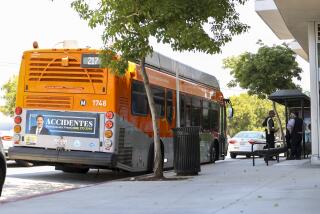Mass Transit Without Masses
- Share via
Here is a little parlor game for commuters in the San Fernando Valley and Ventura County.
Would it be faster to take the Whitnall Freeway (Route 64), which runs east to west through the middle of the San Fernando Valley (just north of Sherman Way) from Burbank to Chatsworth, and then south all the way to the Pacific Coast?
Or perhaps the Reseda Freeway (Route 14) running north to south (just west of Reseda Boulevard) from the San Fernando Valley to the coast?
Or the Pacific Coast Freeway, from Oxnard to Santa Monica?
This is not an entirely fanciful exercise. In the 1960s, the Pacific Coast Freeway was under construction. Phase One was actually completed and stands today between Point Mugu and south Oxnard as a sad monument to what might have been.
More than $10 million of land had already been acquired for the Whitnall Freeway, with construction planned in just a few years.
The 126 Freeway was under construction to connect Ventura with Valencia.
Unfortunately for the region’s gridlocked commuters, these freeways and others like them--all part of Gov. Pat Brown’s visionary infrastructure programs--were canceled in the early 1970s. Highway spending in California plunged, the Division of Highways was abolished and Caltrans was born.
Thus, California began a 30-year experiment with mass transit in the name of every cause from fiscal conservatism to environmental liberalism. Today, Southern Californians are living with the result: a bankrupt mass transit system used by an infinitesimal percentage of commuters and a strangled highway system choked with motorists virtually around the clock.
Has the experiment with mass transit been a good investment? The most expensive freeway ever constructed was the Century Freeway in Los Angeles. It required the condemnation of huge tracts of land and buildings, met a plethora of pricey environmental regulations and was bled by litigation for two decades.
When it was finally completed in 1993, it provided 160 miles of new freeway lanes at the outrageous price of $2.2 billion--or $13.75 million per lane mile.
This year alone, the Metropolitan Transportation Authority will spend $2.8 billion. That means the MTA will consume enough to finance 203 miles of new freeway lanes (at Century Freeway prices), which could have produced an additional 7 million miles of passenger service daily. The $8.5 billion cost of the faltering 79-mile Metro Rail could have added 618 miles of freeway lanes to the Southern California freeway system.
*
So how has the environment fared? Gridlocked automobiles create between two and six times the pollutants per mile as those operating at peak efficiency. Bringing Southern California highways back to capacity would be the environmental equivalent of removing half the automobiles from the roads during rush hours (for nitrogen oxides), and removing five cars out of six (for carbon monoxide).
For years, highway opponents have used the circular argument that new freeway lanes will “just fill right up again,” leaving us no closer to solving our transportation needs.
This argument implicitly recognizes the tremendous pent-up demand for added capacity. Yet instead of meeting that demand, politicians doggedly and dogmatically continue to squander money on a system that the public has consistently demonstrated it will not use.
The Valley Industry and Commerce Assn. recently hosted a “transit summit,” composed of several hundred mass transit advocates from throughout the region. When asked how many came by bus, three hands were raised. Even for the advocates, mass transit is for the other guy to use.
*
VICA’s own survey of commuter preferences underscores the predicament of the transit lobby. According to the poll, a vast majority of area commuters want transit service that requires no more than a 10-minute wait, stops no more than once on the way home, takes no more than 30 minutes in transit and charges no more than 75 cents.
For a Southern California mass transit system, such demands are impossible. Fortunately, what the public is describing is something they already have: the convenience, versatility and economy of the (politically incorrect) automobile.
The cities that came of age in the 20th century formed around automobile transportation. They are sprawled over hundreds of square miles, because the automobile made possible individualized schedules and virtually infinite destinations.
Cities of the 19th century formed around central rail stations, grew vertically, and naturally evolved travel patterns conducive to mass transit.
It is one of the ironies of human nature that the more we invest in our mistakes, the less inclined we are to admit them.
Perhaps it is time for a new generation to recognize the obvious: that Southern California has sacrificed the finest highway system in the world for a mass transit scheme the taxpayers cannot afford and the masses will not use.
More to Read
Sign up for Essential California
The most important California stories and recommendations in your inbox every morning.
You may occasionally receive promotional content from the Los Angeles Times.













